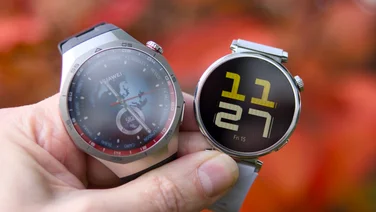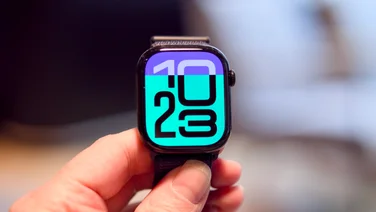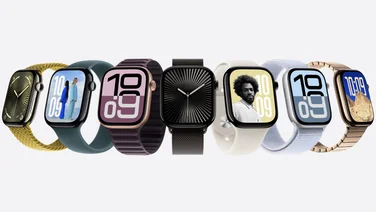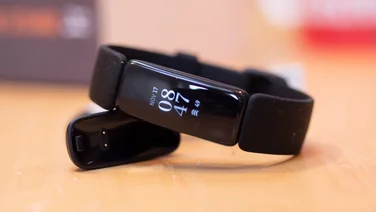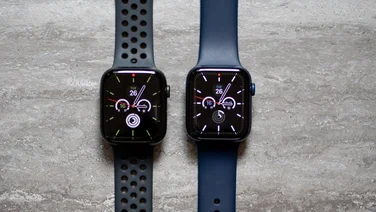To help us provide you with free impartial advice, we may earn a commission if you buy through links on our site. Learn more

















- Android Wear 2
- Packed with sensors
- Decent battery life
- Plastic strap looks nasty
- Expensive
When we wrote the original Huawei Watch review below, back in 2017, the Huawei Watch 2 became the best Wear OS smartwatch. Three years later, and it’s still right up there. And although it’s becoming increasingly difficult to buy new stock is often released onto the market during sales, so it pays to keep an eye out.
The Huawei Watch 2 is still a decent smartwatch, despite its age. That’s perhaps more due to the reality that not many manufacturers are producing Wear OS smartwatches anymore. Samsung, Fitbit and Huawei have their own operating systems for new wearables, leaving Wear OS for the rest.
That said, if you’re set on Wear OS, there are good alternatives. The TicWatch E2 is definitely better value at £146, but it lacks NFC and is far less stylish than the Huawei Watch 2. We weren’t blown away by the Fossil Sport when we first reviewed it but it is better looking and super cheap at £99 today.
If you’re prepared to abandon Wear OS, better options are available. Samsung’s Galaxy Watch is the main contender, even if it’s not a big improvement on its predecessor, the Gear S3. Alternatively the Huawei Watch GT2 and Honor MagicWatch 2 offer very good battery life for around £180.
But the Huawei Watch 2 is still a wonderful wearable, and everything we written below holds true. You’ll be very happy with it if you choose to pick one up in 2020.
Our original review continues below
Sales of smartwatches havent quite taken off in the way manufacturers would have liked them to, but Google, Apple and a host of third-party manufacturers keep plugging away, despite all that. Huawei is among those still game, evidence of which is found in its latest Android Wear smartwatch the Huawei Watch 2.
Announced alongside the P10 and P10 Plus smartphones at 2017s MWC technology show, the Huawei Watch 2 comes in a fitness-orientated Sport version and a more stylish classic variant. Both watches have largely the same core feature set, but with a few key differences.
The Classic has a stainless-steel body and comes with a leather strap, while the standard, sporty model has a plastic body and strap with a ceramic bezel and stainless rear, and adds the option of 4G connectivity.
READ NEXT: Huawei P10 review: The ultimate dual-lens smartphone gets a facelift

















Huawei Watch 2 review: Price and competition
Originally reviewed at £329 and £379 respectively, the non-4G Sport is now available from Amazon for £251 and the 4G variant now costs £319. Both the sports watches and the £359 (once £409) Classic variant are available through select retailers.
Huawei Watch 2 review: Features, display and specifications
The headline feature undoubtedly is the Watch 2 Sports ability to work independently, without the need of a smartphone. Every version of the watch has GPS, so you can go on a run and have it track your pace and location accurately, but the 4G facility is the cherry on the cake here, allowing you to field phone calls and reply to text messages, too.
You need to install a nano-SIM card in the tray beneath the bottom strap attachment, but once youve done that, you can use the watchs built-in microphone and speaker to dial out and answer calls, while Android Wear 2s new smart replies, dictation and onscreen keyboard let you answer and send texts directly from the watch face.
To be honest, Im not entirely sure why youd want to answer the phone while youre out on your daily run, but at least theres the option. And if you dont think you want or need the 4G connectivity, the non-4G version is cheaper and offers everything else you need for fitness tracking, with built-in GPS and a heart-rate monitor to keep tabs on your ticker.

















And theres plenty to like about the rest of the specification as well. Both variants have a circular 1.2in, 390 x 390 AMOLED display with an ambient light sensor that adjusts brightness automatically. This display is sharp and colourful its just a shame Huaweis stock faces are so unsophisticated in appearance.
Both variants are powered by the new 1.1GHz Snapdragon Wear 2100 processor Qualcomms first dedicated wearables chip and each has 768MB of RAM, which is plenty for a smartwatch.
Theres also 4GB of internal storage so you can store music on the watch and listen directly via Bluetooth headphones, NFC so you can use Android Pay from your wrist and, perhaps most important of all, a large 420mAh battery delivering a 40% increase in capacity over the first-generation Huawei Watch.
Overall, I was pleased with the performance of the hardware. The screen is bright and sharp when you need it to be and it dims to a level where it doesnt blind you in the middle of the night. And, largely, its a responsive device to swipe your way around. Its prone to the odd pause and delay here and there, though, something Im hoping a firmware update will resolve in time.

















Battery life is fine, though. It isnt quite as good as the Samsung Gear S3, which lasted two to three days in normal use, but I found that by disabling Wi-Fi and sticking just to Bluetooth, it would last two working days comfortably. It didnt quite stretch to a full 48 hours, and enabling 4G dropped the battery life to around a day, but the watchs ultra-battery-saving mode, which disables all functions apart from step counting and the watch face, will get you to the end of the day however long is left of it.
READ NEXT: Best Bluetooth headphones and earphones our pick of the best of 2017
Huawei Watch 2 review: Design
Both the Huawei Watch 2 Classic and Sport have a slightly bulky design and I find it odd that Huawei hasnt included a rotating bezel or crown, instead offering two push buttons on the right-hand edge of the watch casing. Its a slightly odd design choice from the Chinese manufacturer since the Android Wear 2 interface has specifically designed with this type of hardware in mind.
Still, the Watch 2 is attractive to look at. The Watch 2 Classic is the best-looking variant, all encased in brushed stainless steel, but I also have a soft spot for the sports models glossy black ceramic bezel. Theres something brooding and high-tech about it that the standard watch just doesnt have.
I do find the Watch 2 a little bulky, though. Despite being lightweight at only 40g for the Sport and 47g for the Classic (without straps), the Huawei Watch 2 is 12.6mm thick and it looks bulky on my wrist.
And the straps dont look great either. There are several different colours available Dynamic Orange (4G), Carbon Black (4G and non-4G), Concrete Grey (non-4G), while the Classic comes with Titanium Grey (non-4G) but whichever you choose, the textured plastic doesnt look very nice.
Another surprising design choice by Huawei was to reduce the visible screen size from 1.4in down to 1.2in in the Watch 2. Its a small difference, but noticeable if you compare the two versions together.
READ NEXT: Huawei Watch review an excellent smartwatch with impressive battery life
Huawei Watch 2 review: Android Wear 2
The smaller screen also puts a bit of dampener on the Huawei Watchs next great feature: Android Wear 2. Thats because among Wear 2s best new features is an onscreen keyboard that allows you to swipe out words, just like you do on your smartphone.
In general, Ive been impressed by Android Wear 2s ease of use and accessibility. Its much more intuitive to use than the previous version, and its relatively simple to understand how things work.

















Its biggest update, however, is standalone apps. The theory here is that by installing some to the watch directly, youll be able to use the watch on its own without the need for a paired smartphone at all. For example, youd be able to listen to your online playlists or get your email even if you left your smartphone at home. Useful if you own the 4G version of the Huawei Watch 2, or for iPhone owners who want to use something other than an Apple Watch.
This wont make its presence felt fully, however, until more developers start producing apps that can be downloaded and installed locally. While the Huawei fitness app worked on the watch without a phone present, and I was able to install Google Maps to local storage and use it for directions, Spotify refused to work without my smartphone being present and Gmail couldnt be installed directly, either.
One thing that will make an impact from the off is the way Android Wear 2 now supports Android Pay from your wrist. Once youve set this up and authenticated the watch, you can access the feature with a double-press of the bottom side button. I found this worked but was a little slow on the uptake, particularly in comparison to Apple Pay on the Apple Watch. It took a little longer than Id like to read at contactless payment terminals. I also found it to freeze from time to time, making it slightly frustrating to have to re-launch the app.
I also love the Google Assistant implementation in Android Wear 2. In particular, it seems far more responsive than the voice recognition on previous Android Wear smartwatches Ive worn, and the dictation feature, which can be used in preference to the keyboard feature for replying to and writing texts and other messages, works absolutely beautifully for the most part.
READ NEXT: Huawei P10 Plus review: A gorgeous phone despite the hefty price tag
Huawei Watch 2 review: Fitness features
Despite having an onboard GPS and heart-rate monitor, fitness is an area where Im not entirely convinced by the Huawei Watch 2. It comes with its own Huawei-branded fitness app that delivers everything from training plans to on-watch guided workouts. It tracks all sorts of metrics, displays a neat graph on the watch itself of your heart rate during exercise and estimated VO2 capacity (among other things), and it works well in conjunction with the watchs heart-rate monitor and GPS sensor.
However, for all its fancy features, I found the Huawei Health app misses out one key thing: it doesnt make any attempt to auto-detect fitness activities. While this isnt a problem if youre planning on using it to go running with, as thats a distinct and easily defined activity, you want activity such as brisk walks to be detected without intervention, since you dont always know when a light stroll will turn into something more demanding.

















I often found myself starting a walking activity using the Huawei fitness app, but then forgetting to terminate the session and only putting a stop to tracking hours later. That has obvious implications for battery life, but its also not great if you want to gather a more detailed picture of your overall fitness and activity. This is why I currently rate the Samsung Gear S3 as a better smartwatch for overall fitness tracking.
READ NEXT: Our pick of 2017’s best smartphones
Huawei Watch 2 review: Verdict
There are some irritations, then, with the Huawei Watch 2, but in general, I like it. The battery life is good, I like the look of both variants, and its packed with all the sensors you could possibly need.
Android Wear 2 makes it simple to use and adds the ability to use Android Pay, and despite the weaknesses of the Huawei Wear app, it is undoubtedly a boon to be able to cut loose from your smartphone and go on a run without it.
The only fly in the ointment is the price. At £329 for the non-4G sports version, £379 for the 4G sports watch and £409 for the classic, it is a little pricey for a smartwatch.


